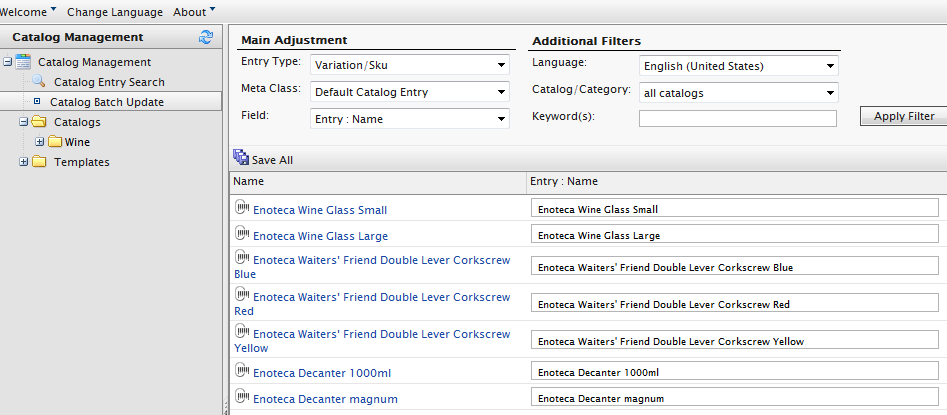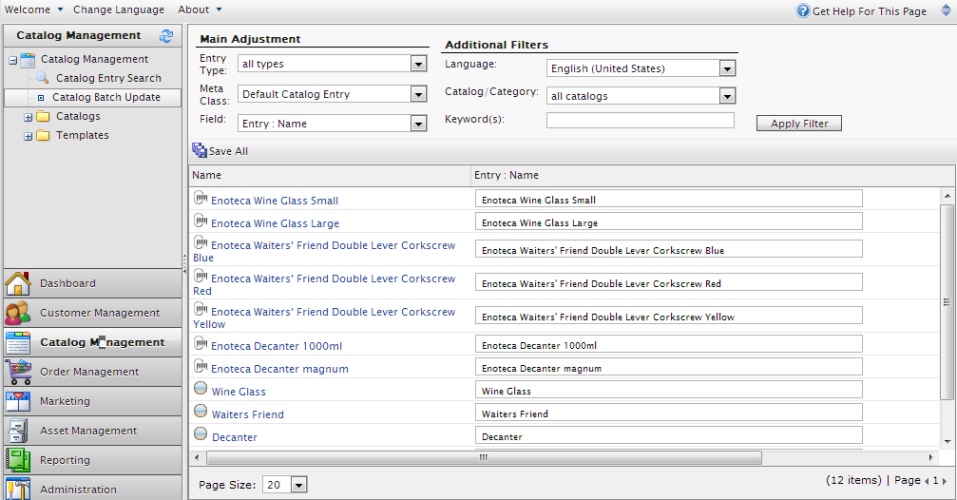 Editing catalog entries
Editing catalog entries
After you import products and variants, you can add to, edit or delete them.
Properties for products Commerce: various forms of merchandise that you can display and purchase from the public site, including products, variations/SKUs, bundles, and packages. Also known as a catalog entry. and variants Commerce: a variant or SKU corresponds to a specific product with specific characteristics. For example, a product line of shirts has individual variations/SKUs that include size, color, and collar size. are similar, but pricing and inventory information is only defined for variants. See also: Catalog entry properties
Changes to related entries Commerce: lets merchandiser assign items related to current one, to entice shoppers with upsell or cross-sell items; Appears on product's related entries tab., pricing and inventory information are immediately published and visible on the website, and are not part of the publishing flow.
Changes to content and assets Content such as documents, videos, and images that can be linked to other content such as pages, blocks, and catalog entries in Commerce. must be published to become visible on the website. See Working with versions for publishing information.
Catalog-specific editing options
The catalog item list has on the top right a Select view with additional editing options. Use these to edit and access the Pricing, Inventory, Categories, or Related Entries views.
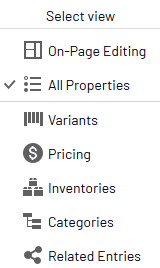
Editing multiple catalog entries
You can work with several catalog entries at once by
- Selecting items.
- Clicking toolbar buttons, such as cut, copy, paste, or delete.
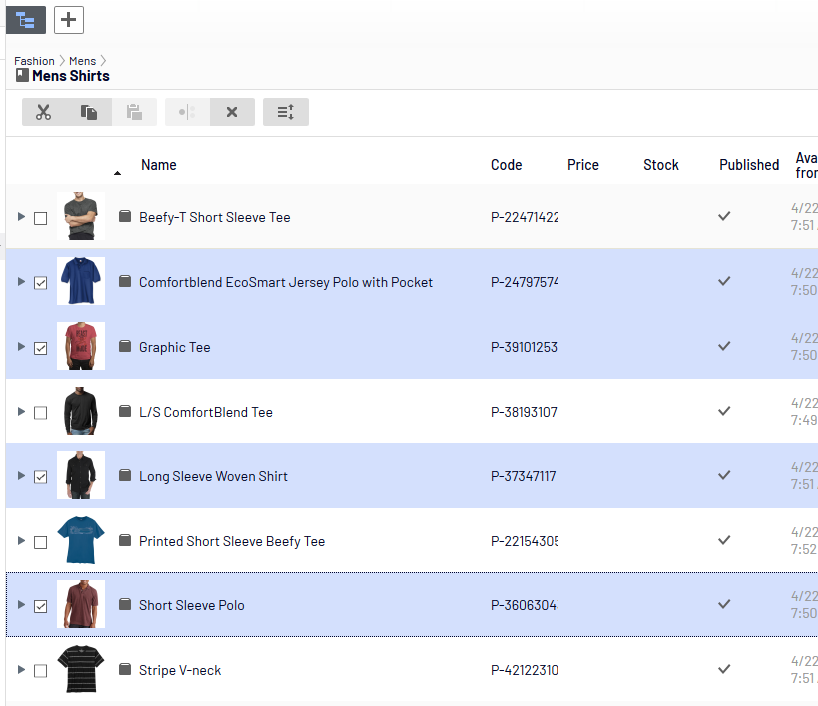
Updating multiple catalog entries at once
As a catalog Commerce: a top-level container for catalog entries such as categories, products, and variants (SKUs). grows larger, use the Catalog Batch Update to update multiple catalog entries at once. The option lets you filter items of interest then update several at once.
- Go to Commerce manager > Catalog Management > Catalog Batch Update. The Batch Update screen appears.
- Main Adjustment.
- Entry Type. Select Product, Variation/SKU, Bundle, or Package.
- Meta Class and Field menu items depend on the Meta Class you select. Your selection populates the Field drop-down selections.
- Additional Filters.
- Use the Language filter to select entries by language.
- Use the Catalog filter to narrow the results to one catalog.
- Enter keywords, such as Wine Glass, to narrow the search further.
- Main Adjustment.
- Within search results, you can:
- Select a catalog entry and go directly to its edit page.
- Use the Field drop-down to edit a field across several catalog entries. For example, change the display price for a group of variants. Using the Field drop-down list, choose Variation: Display Price. The right column changes, letting you update the display price for all catalog entries.
- Click Save All.
Sorting catalog entries
Sorting means changing the display order of items in a category. This affects the Catalog view.
Sorting can also change the arrangement of items on your website's pages. When creating your page templates, a developer determines how to arrange the items on a page. Sort order is one option.
To sort catalog entries, follow these steps.
- Go to the category that contains items you want to sort.
- Click the Sort button
 . This enables sort mode.
. This enables sort mode. When sort mode is enabled, a drag handle
 appears to the left of every eligible item's check box.
appears to the left of every eligible item's check box. - Select one or more items whose sort order you want to change.
- Drag and drop items to the new position.
Or, to sort a single item, move to its far right, click to open the context menu, and select Move Up or Move Down.
Notes about sorting
- Changing an item's sort order affects it within that category only.
- Sort mode remains enabled until you click the button a second time, even if you go to other categories.
- You cannot sort categories.
Sorting variants
To sort a catalog entry's variants, follow these steps.
- Select the catalog entry whose variants you want to sort.
- Click Select view > Variants.
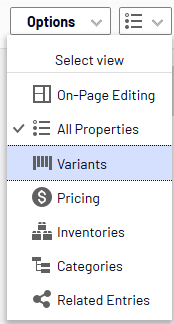
- Drag and drop variants to a new position.
Duplicating catalog entries
You can duplicate an existing entry to create a new entry. If you do, it gets a unique ID, and you can edit the following details. You can then move the new entry to different catalog tree location.
- If you duplicate a category, Optimizely Commerce creates a new code, name in URL Stands for "Uniform Resource Locator". Also known as a web address such as http://world.optimizely.com., and SEO URL Corresponds to simple address in CMS. Depending on the site setup, it may be used instead of the hierarchical URL when links are rendered in outgoing responses. For incoming requests, the site always responds to the SEO URL, regardless of settings. For more information, see http://world.optimizely.com/blogs/Magnus-Rahl/Dates/2013/12/Replace-SEO-URL-generation-in-EPiServer-Commerce-75/., based on the original. Name, internal name, and content are the same as the original. Sub-entries in the original category, such as products and variants, are not duplicated.
- If you duplicate a product, variant, package, or bundle, Optimizely Commerce creates a new URL name, SEO URL, and product code based on the original. Other information (name, internal name, content, and so on) is the same as the original.
You can duplicate one or several catalog entries. The following example duplicates multiple variants and moves them to a different category.
- Open the desired catalog or category node, so items you want to duplicate appear in the catalog item list.
- Pin the catalog tree so it remains open.
- Select items to be duplicated.
- Drag selections to the desired catalog tree location.
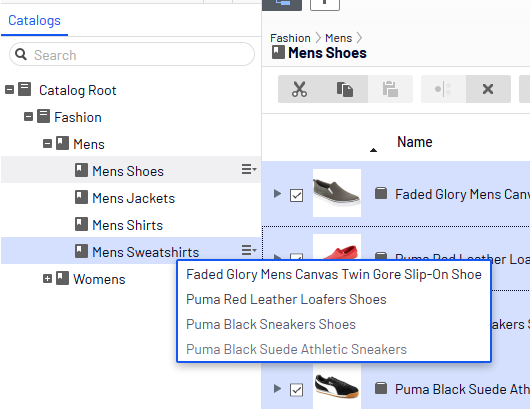
- The Select Action dialog box appears. Click Duplicate. The selected entries are duplicated in the selected location.
You can also use the List menu's Copy and Paste options to duplicate multiple entries, or the Context menu's Copy and Paste options to duplicate a catalog entry.
Moving catalog entries
Moving a catalog entry is the same as assigning it to a different primary category. See Changing a catalog entry's primary category.
Deleting catalog entries
When deleting a product Commerce: various forms of merchandise that you can display and purchase from the public site, including products, variations/SKUs, bundles, and packages. Also known as a catalog entry. or a variant Commerce: a variant or SKU corresponds to a specific product with specific characteristics. For example, a product line of shirts has individual variations/SKUs that include size, color, and collar size., the following happens depending on how the deleted entry is related to other catalog Commerce: a top-level container for catalog entries such as categories, products, and variants (SKUs). entries:
- If a product or variant is deleted, all links from other catalog entries to it are removed.
- If a product with associated variants is deleted, the variants are left associated with the deleted product's category.
See also: Deleting a package or bundle
You cannot undo the deletion of catalog entries.
To delete a product or variant, select an item, open its context menu, then click Delete.
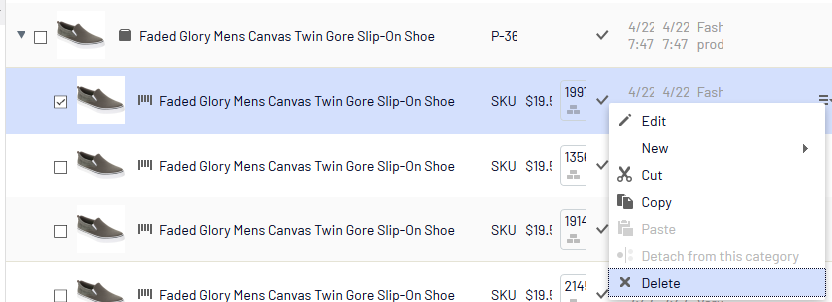
To delete multiple catalog entries at the same time, select the entries then click Delete in the toolbar.
Translating catalog entries
Like other types of content, catalog entries can exist in multiple languages. See Multi-language management.
